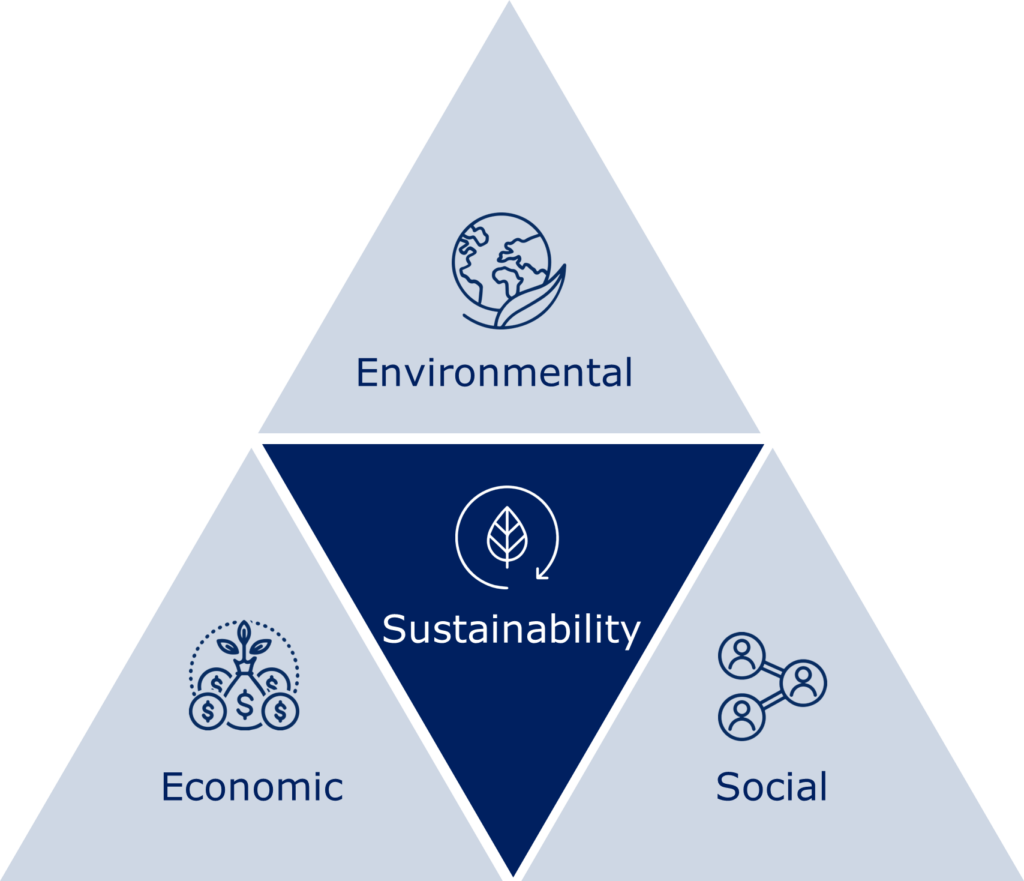When is a building actually considered sustainable?

The unchecked CO2 emissions combined with the current energy crisis make the massive need for action clear: We have to conserve energy!
Buildings play a central role in this respect, as they account for 40% of the global consumption of primary energy sources, primarily gas and coal. 99% of buildings are existing structures, and it is not economically feasible to carry out a full renovation to improve their energy efficiency. In order for alternative, sustainable measures to be implemented, there needs to be social acceptance and economic benefits in addition to energy savings. In other words, the entire value chain needs to benefit from sustainability measures, otherwise even these alternative solutions will not achieve the desired goal. The sustainability triangle symbolizes this logic:
The building sector is an excellent example of the possibilities and benefits of digitization when it comes to achieving sustainable energy savings. There are a number of impressive figures to show why smart buildings digitized with Smart Spaces solutions are so promising in this context:
- Environmental: Up to 44 percent energy savings thanks to the combination of desk sharing (25%) and smart heating (26% for the remaining three-quarters of the space)
- Economic: Desk sharing achieves cost savings of two million euros per year for 1,000 employees (8,000 euros operating costs per workstation on the European average, according to the 2019 “office cost report”Bürokostenreport” by facilitymanagement.de, 25% of desks saved)
- Social: Consistently good air quality and modern working models increase employee productivity by as much as 50 percent
User acceptance for desk sharing
Companies could even implement desk sharing in a very straightforward manner using Excel, Outlook, or QR codes. In such a scenario, employees would use their cell phones to scan the QR code at the selected desk, thus sending the information that the workstation has been assigned. But what happens if their battery is dead, or if employees forget to scan the code, or if they don’t want to check in personally to protect their privacy?
A semi-manual solution like this simply overlooks user behavior, since the necessary data on actual desk occupancy is not supplied automatically. Sensors depict the actual situation in real time – independent of the individual user, which is indispensable when it comes to automation and privacy protection. Both, in turn, form the foundation for good function and ease of use and are therefore prerequisites for ensuring that employees will still be happy to use the application in a year’s time and that the investment will pay off in the long term.
Wired versus wireless sensors
Sensors are needed for sustainable applications. Wired sensors are not cost-effective. With wiring costs of over 100 euros per sensor, the typical acquisition costs are tripled. A wired solution is also inflexible; each time a change is made, time is lost and new wiring costs are incurred. This is why truly sustainable applications use wireless sensors.
Where do wireless sensors get their energy from?
Some wireless sensors use batteries. A major disadvantage of this solution is the high maintenance costs. On average, it costs around 250 euros to have a battery replaced by a professional service provider (travel, replacement, testing, documentation). Even if all system batteries are replaced at the same time as a precaution, that still adds up to ten minutes or 25 euros per sensor per year: The effective sensor costs have thus already doubled after two years. Not to mention the battery waste that is generated on a regular basis. Battery-free wireless sensors are environmentally friendly, significantly reduce both system costs as well as any hassles during operation, and are thus a basic requirement for a sustainable overall solution.
Interoperability as a factor for sustainability
As expected, space management and/or energy savings are just the beginning of what will be a fully comprehensive smart building in the future. This is why it is so important to pay attention to modularity and interoperability of the systems and products used.
Examples of the most important sensors and actuators in a smart building:
- For space management: occupancy sensors for rooms and desks and people counters
- For health and cleaning: air quality sensors, service call buttons, and area management sensors for detecting cleaning needs
- For energy savings: temperature sensors, battery-free wireless heating valves, and load switches for detecting and switching off loads in standby
In the end, the sensors still need to be connected to the cloud. This can be done either conventionally via gateways or, more recently, via WiFi access points, which then also eliminates the wiring of additional IoT gateways.
With all the factors mentioned above, self-powered wireless sensors get to the heart of sustainability and are an important cornerstone for sustainable digitization.



